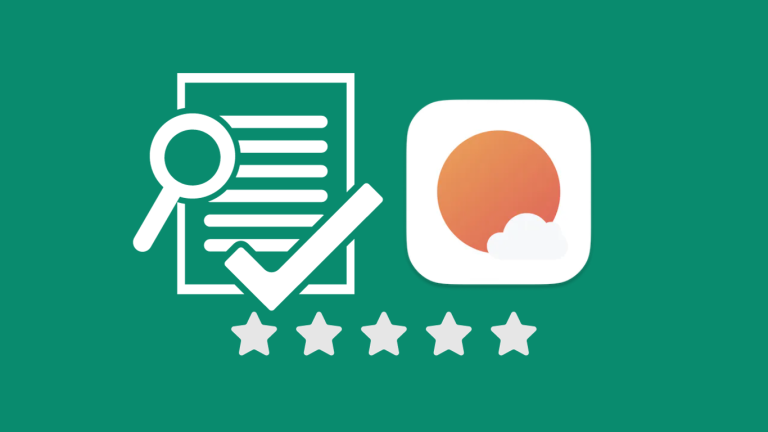Note: This article is a sponsored collaboration with Popl & Mobilo, but my thoughts and evaluations are entirely my own. This post includes affiliate links, meaning I may earn a commission if you make a purchase through them, at no additional cost to you. See full disclosure for details.
You’re reading this because you’re curious if Motion AI can streamline your productivity and project management challenges.
In short? It’s not perfect. Still, it’s the tool I rely on daily, so let me share my perspective.
I’ve spent months diving deep into the world of productivity apps, and one thing’s clear: no tool is a cure-all. They can assist, but they won’t magically fix everything.
That said, plenty of apps out there can help you stay organized and lighten your mental load by putting your tasks into a clear system.
Let’s dive into this Motion app breakdown to see if it’s right for you.
My Honest Take on the Motion App
Why Trust My Opinion?
I’ve been exploring AI and digital tools well before they hit the mainstream. With a background as a Realtor, pharmacist, and now an online business owner raising three young kids, I understand what different users might need from a project management platform.
I first tested Motion over a year ago when it was still in its early stages. Back then, it lacked robust project management or scheduling features, so I moved on quickly.

After experimenting with other tools like ClickUp, Trello, and Sunsama (check my digital planner comparison), I learned Motion had gotten significant upgrades. So, I gave it another shot.
What Do You Want in a Project Management Tool?
Before I share my experience with Motion, let’s clarify what I need from a planning app and how that might differ from your priorities. Here’s what I look for in a calendar or task management system:
My goal is to manage multiple businesses and calendars simultaneously while keeping my content schedule organized, but I don’t need anything overly intricate.
So, What’s Motion AI All About?

If you’re a freelancer or small business owner, you’re likely searching for a tool to streamline your tasks and projects. Whether you’re handling a small team or flying solo, things can pile up fast.
When you start looking for ways to organize your workflow, you’ll notice there’s a flood of apps out there, each falling into a few key categories.
Many apps focus heavily on one feature while offering bits of the others. Some users mix and match multiple apps to cover all bases—it’s all about finding what works for you.
Ultimately, these tools are solid, but each serves a unique purpose, so what’s perfect for one person might not suit another.
Let’s explore whether Motion AI is the right choice for you or your team.
Taking Motion AI for a Spin
Let’s start this Motion review with a look at its core setup. You get three main hubs: Calendar, Projects, and Booking.
Hub 1: AI-Powered Calendar
When you log in, you’ll likely land on the calendar view by default. It pulls together your work and personal calendars into one spot. As of now, it syncs with Google Calendar, iOS Calendar, and Outlook.

The calendar’s standout feature is its auto-scheduling, which builds your days, weeks, and months for you.
It prioritizes fixed events like meetings or appointments. Once you add your tasks or projects, Motion AI steps in like a virtual assistant, arranging your schedule automatically.
How Does the AI Plan Your Day?
You might wonder how it decides which tasks go where.
When you join Motion AI, you start by setting up your preferences. This involves syncing your calendars, defining your work hours for task scheduling, and adding your projects and tasks.
After you input your settings and tasks, it creates a daily plan based on:
- Priority (tasks with higher importance get slotted earlier in your day).
- Due Date (when the task needs to be finished, whether it’s a firm or flexible deadline).
- Time Needed (you can allocate full hours to a task or break it into smaller segments).
- Free Slots (it fits tasks into your work hours around meetings unless you override it).
As you can probably tell, setting the right priority for your tasks is key to maximizing Motion’s potential.
My favorite part of the calendar is how it tracks must-do tasks and checks if you’ve set aside enough time for them. For example, one week my family was hit hard by a brutal flu, and we got nothing done. Here’s what my alerts looked like during that chaos.

From there, I could pick which tasks were non-negotiable that week to hit deadlines, while pushing back the ones I hoped to tackle. Extending those deadlines reshuffled my whole schedule, moving things to the next week seamlessly.
This flexibility is what won me over with Motion. As a solopreneur with kids, I need that adaptability. I’ve enjoyed other tools (see my Sunsama review), but replanning everything manually after a disruption like that was a time sink I couldn’t afford.
Dashboard 2: Motion’s Project Management Hub
To really get the most out of Motion, you’ll want to use it as your main project management tool.
If you’re already using something like Asana or ClickUp, there’s no direct integration. You can connect tasks through Zapier, but I’m not sure how well that works. Completing a task in Motion might not sync back to your other system—you’d need to verify that yourself!
That’s why I suggest going all-in with Motion if you want it to be your primary project and task hub.
How the Project Management Hub Functions
As shown below, you can sort your work into workspaces. Think of these as sections of your business—like product design, sales, support, or marketing.
Inside each workspace, you can set up different projects.
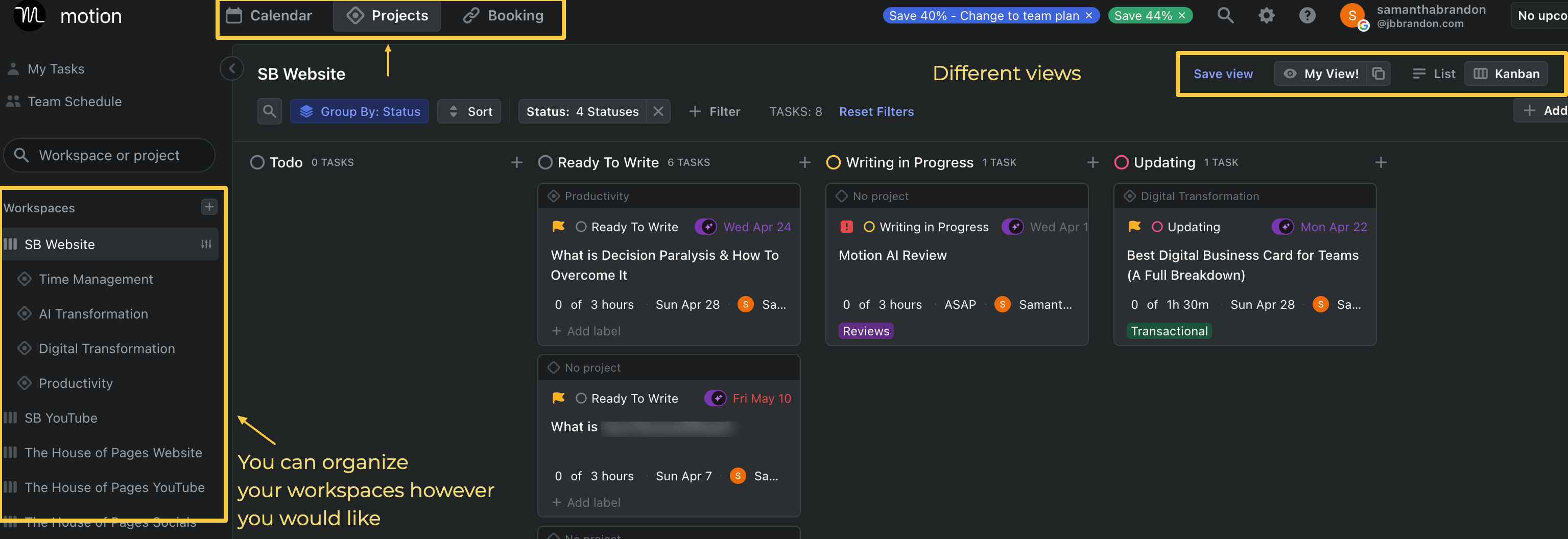
For a digital marketing agency, you could make a workspace for each client, then divide their work into projects within those spaces.
As a content marketer like me, I create workspaces for each part of my business. Above, you’ll see I’ve got ones for YouTube, my website, social media, and so on.
Tasks Vs. Events
In Motion, everything’s either a task or an event.
Adding Tasks
Here’s what it looks like when you set up a task:

As shown, you can add simple details like descriptions and build a to-do checklist for each task.
The real power lies in the right-hand panel. That’s where you set the status, assign it to someone, pick a priority, set a due date, and estimate the time it’ll take. These choices shape how Motion slots it into your day.
Tasks with top priority or nearing deadlines get bumped up to be tackled first.
Team Features
You can assign tasks to team members right within each one, making it handy for coordinating across groups.
There’s also a log of updates and changes for each task, so you can track how a project’s progressing.
Next up, let’s explore the scheduling tool.
Dashboard 3: Booking and Scheduling Tool
When Motion’s linked to your personal and work calendars (which I highly recommend and enjoy), the scheduling tool really shines. For my mostly virtual meetings, I can send out an email or a link so people can pick from my open time slots.
You can tweak a bunch of settings for this—here’s what the booking link looks like:
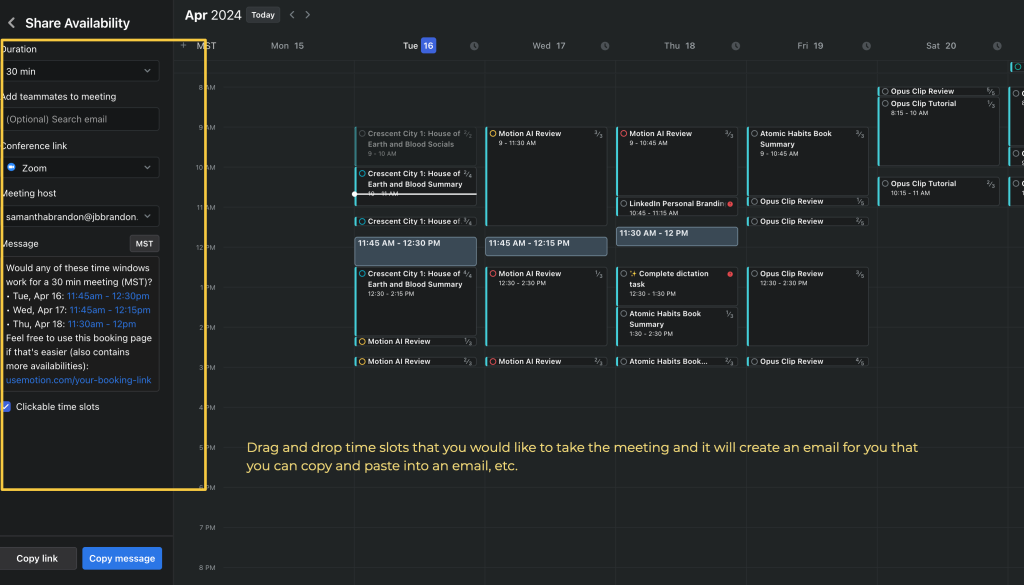
I didn’t come to Motion for this, but it’s turned out to be a pleasant surprise.
Review Time: What I Think Motion Nails
After five months with this tool, here’s where I think it really excels.
#Pro: AI Autoscheduling
This is why I’ve stuck with Motion over other apps with similar offerings. My schedule’s always shifting—I’ve got three kids, and unexpected priorities pop up all the time. Life’s unpredictable. Plus, when booking, it safeguards your focused work blocks.

With tools like Sunsama (which I still liked), I spent too much time planning my day and not enough doing the work. When chaos hit—like a kid getting sick—all that planning was wasted.
Motion fits me because when life throws a curveball, it’s no sweat. It reshuffles my day, bumps tasks to tomorrow, or flags when I’ve overcommitted, forcing me to rethink what’s urgent. It simplifies everything.
#Pro: Project Management
I tried Motion years ago as a productivity app and found it pricey for what it offered then. Now, with project management and booking bundled into one plan, it’s a solid value for me.
The UI/UX isn’t the slickest I’ve seen (especially if you’re used to Trello), but it grows on you fast. Here’s how my Kanban view keeps me on track:
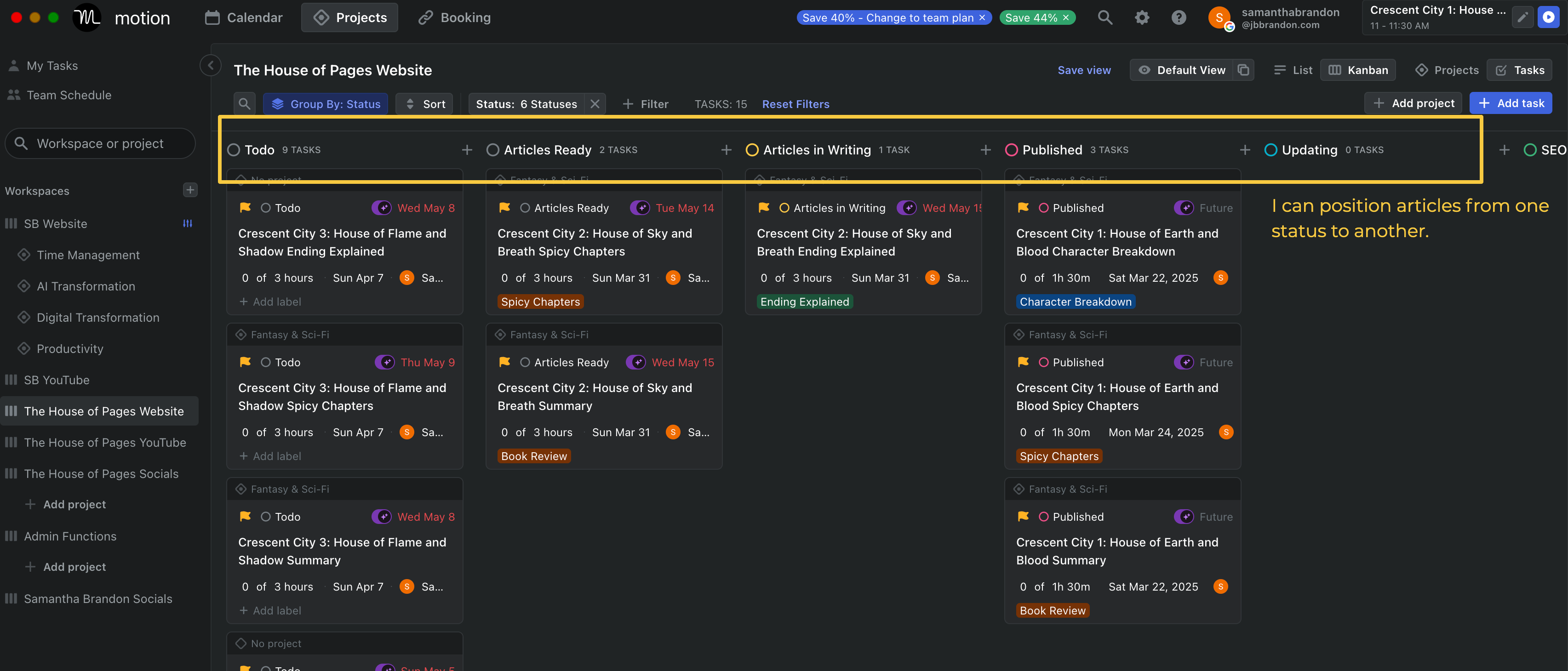
You get views like Tasks, Lists, and Kanban, and can save your favorite setup.
#Pro: It’s a Solid Task Manager
I’m impressed by the variety of ways to add a task. Beyond manually entering it on the desktop, you can:
#Pro: Recurring Tasks Are a Win
The recurring tasks option is a lifesaver for me. I reserve time daily for emails at day’s end and set weekly slots for financial reviews, reflections, and recaps.
It helps me carve out moments to refocus and keep everything on course.
So, What’s Not Great About Motion?
Here’s the honest scoop. What might bug you if you jump into Motion?
#Con: Steep Learning Curve, Not Super Intuitive
As an Apple fan, I expect a UI/UX so simple my kindergartner could figure it out. Motion’s training resources are underwhelming—there’s some info on their site, but it’s pretty basic and low-effort.
That said, I made a quick tutorial—under 30 minutes—that I think you should check out (yes, I’d love the views, but it’s genuinely helpful, and I wish I’d had it starting out). Watching any YouTube guide will save you a lot of headaches getting up to speed.
#Con: No Subtasks… Checklist Feels Meh
Imagine a big task, like making a YouTube video. It’s got tons of smaller steps, but Motion won’t let you break it into proper subtasks.
They offer a checklist you can tick off—here’s how it looks:
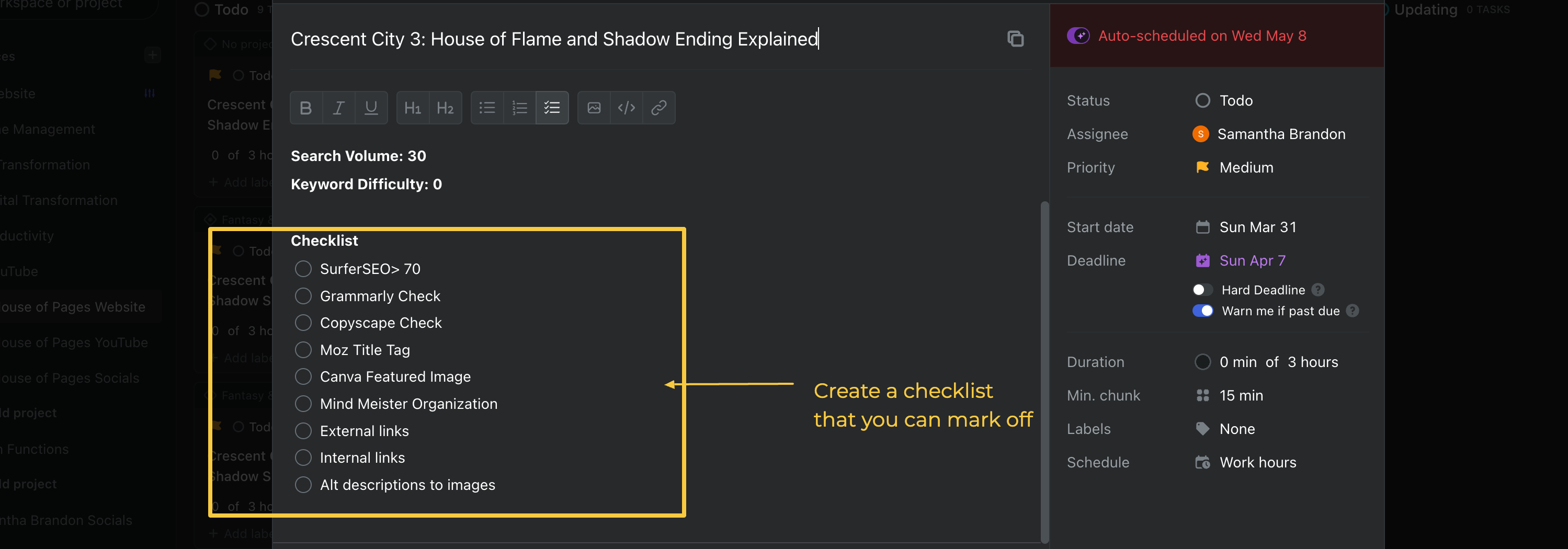
But the checklist items aren’t tasks themselves. I’d love to turn each into a task for batching purposes.
For instance, I do 2-3 YouTube videos weekly, each a separate task. On Mondays, I’d rather write all three scripts together, then film them in one go when I’ve got childcare. Motion’s calendar doesn’t support that flow.
#Con: Auto-Scheduling Doesn’t Always Match My Flow
Motion’s calendar auto-plans your day for you. Trouble is, it doesn’t always align with how I’d like it.
Some of this might be my fault—I’m not always great at setting priorities and deadlines perfectly. Still, I fix it by picking a task, hitting “Start Task Now,” and letting it reshuffle everything else.
#Con: Weak Weekly Reflection Tools
If you want Motion to double as a productivity tracker, it might disappoint. It lacks weekly reviews. By contrast, Sunsama, a key rival, gave me breakdowns of time spent on meetings, writing, filming, or whatever I tagged.
I’d love it if Motion offered that so I could organize my life better and get a clearer sense of how long tasks really take me.
#Con: No Native Integrations
You can pull in tasks via Zapier, but don’t expect built-in integrations. Motion works best as your main task hub, not so much if you’re syncing it the other way around.
Motion AI For Students?
I wish I’d had this back in my student days. I know Notion (yes, with an N, not M) is the hot pick for students now, but as someone who went the full academic route (Bachelors in Biochem, Business Minor, Doctor of Pharmacy, plus a residency year), Motion could’ve kept my daily tasks on track and my focus sharp.
Notion takes too long to set up for students, in my view—Motion would’ve been faster.
Motion Pricing
Motion isn’t budget-friendly. You can pay monthly or snag a discount with an annual plan—here’s the pricing as I’m writing this.
I’d definitely suggest grabbing their 7-day free trial first.
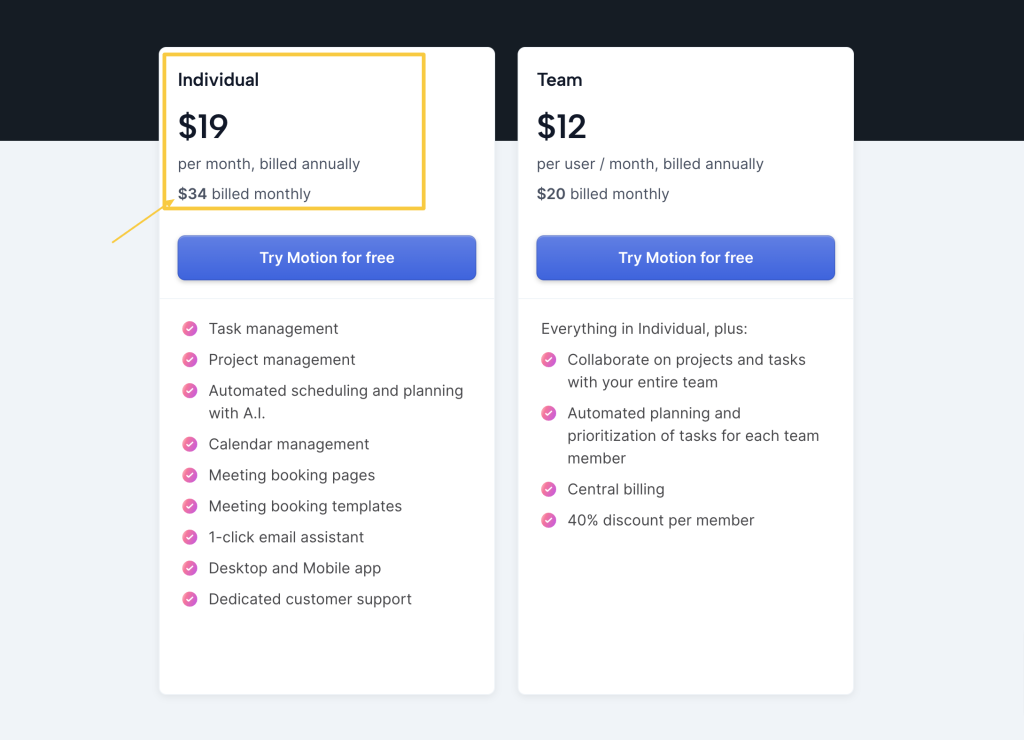
We’re having coffee, would I recommend Motion to you?
Picture us as besties chatting over coffee, and you ask if Motion’s worth it.
I’d say yes if you’re a solopreneur, content creator, agency owner, or run a small team (say, up to ten people). For a huge company with 500+ staff and tons of complexity, I’m not sold on its project management chops yet—it’s still green compared to heavyweights like Asana, Monday, or ClickUp.
What about you? Have you given it a shot? Share your take in the comments!
If you’re tempted to try Motion, use this link—it gives me a small commission to keep doing these detailed reviews, at no extra cost to you. Thanks a ton!






